Our latest interview is a special one, Bill Kendall was with SOG in the early days, from 1964 to 1965 and then did another tour at CCC in 1968. This was a great period of change for SOG with the change over from CIA management to being run by the Army. The early years had a focus on agent insertion into North Vietnam and less on cross border reconnaissances into Laos and Cambodia.
Bill has also allowed us to access his extensive photo archive including rare images of the SOG operations at House 10 in Saigon.
Bill Kendall: Interview
SOG 1964-1965: House 10 and Agent Insertion
SOG 1968-1969: CCC, Kontum and running recon
Bill Kendall Album: Graduation pictures and current photos
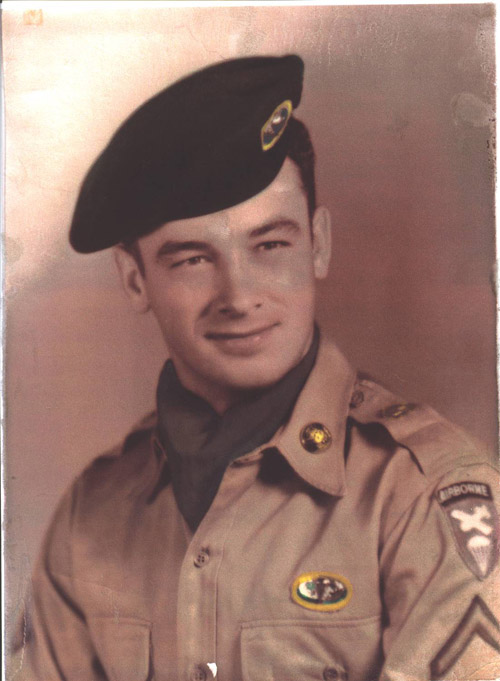
Bill Kendall with the 77th SFG in 1955
Modern Forces: Tell us about your background and military service?
Bill Kendall: My back ground is not that much different than the average individual that may have served with MACVSOG or on one of the teams, ie Green Light, White Star, CCC, CCS, CCN, DELTA, or with the 5th SF in Nam. There were other organizations before these projects that worked with CSD prior to members of SF assuming the rolls and missions of CSD.
I graduated from high school in May of 54 and enlisted in the army on 23 Aug 54. My original intent was to join the navy but indicated I had rheumatic fever as a child for about 4 years and that made me 4-F on that application to join the navy. That was on the week before I went back to Boone, Iowa to join the army.. I left that bit of info off of the application to join the army on the 23th Aug. When I was asked what I wanted to be, I told SGT Blackmur, I remember his name, I wanted the toughest army unit that I could get into.
Modern Forces: What made you join Special forces and then apply for SOG, did you know what it was before you joined?
Bill Kendall: At that time unknown to me they were organizing the 77th Special Forces Group to replace the 10th which had been sent to Germany in Sep 52. SGT Blackmur indicated that a new unit, called Airborne Unassigned, was being formed at Ft Bragg. I ask for and got that assignment without knowing what I was getting into at that time. Special Forces was an unknown military unit at the time within the military forces.
I have to say I did have an attitude problem while in high school because I was on the small side, 5'5" and weight at the most 135 lbs. Had a lot of fights. Lost more than I won but still had fun. Played football, basketball, and run on the track team. Was not really good at any of it but liked the competition. Last year of school was expelled twice, lost a couple of small scholar ships but didn't plan on going to college any way.
I finished basic and advanced training at Camp Chaffee, AR, with INF and FDC being my MOS's. Because of my high scores on the test I took, average of 137 on them, they felt I should go to OCS, but that was not part of my desire to be an officer. Reported in to old FC1 at FT Bragg, NC of the 77th in December 1954. At the time I did not know either of them men, but CPT Happerset was the CO and Doc Adams was the 1SG. I was told by MSG "Doc" Adams on that first day reporting in, I was not big enough to break the deployment bag ties on a parachute to be airborne. Have to say I did not have the foggiest idea what he was talking about at the time, but I will say Doc was a bit man and he scared the H--- out of me. Doc would end up being one of my best friends during the next 20 years of my life. Never did know what his first name was. Everyone called him "Doc" and you did not ever call him anything else for fear of losing your life.
I finished 8 weeks of the earlier SF training prior to going to jump school. We started with about 160 men. Finished less than 50 after the eight weeks. In February of 1955 we started jump school at Ft Bragg, That was 4 weeks of fun for me. Have to say I was in great shape and that helped a lot. Doc caused a couple of problems for me while I was in jump school but won't go into that. Had to do a lot of push-ups because of him.
Graduated from jump school in early March 55, will attach a picture of me then (see below), and a CPT Kaufman and CPL Linwood E. Pate came to the barracks when we finished jump school and wanted to know if any of us wanted to go to parachute rigger school at Ft Lee, VA. I should tell you out of the 50 or so men that started jump school only 9 of us finished. My number was 487 because I was the smallest and the last one in the last platoon in that jump class. Some stories go along with that too.
Modern Forces: You joined SOG from its inception, how did its structure and role differ from latter years and what were your primary missions?
Bill Kendall: SOG was not really part of anything you really ask for. It just happened to me. In my early years after completing rigger school and assigned to the 77th SF while working as a rigger, I became involved in a project called "Green Light".. All I will say except it was training team or teams for a particular mission. After leaving that and going back to the rigger detachment I was told I would be going overseas to another resupply unit located in Japan.. Earlier stories indicated that SF was in South-East Asia during the period of 1957 but it was prior to that. I can say that there were several supposedly covert elements operating under such designation as (example only) 8052nd, 8081st etc. One of the units would go on to form what was know as the 1st SF in Okinawa. A couple of the units would rotate back and forth from Japan to other places in the far east on TDY type missions for 3-6 months. Keep one thing in mind, "I am only indicating possible senarios". I can say I did drop a lot of resupplies someplace over there in the year I spent there. The unit I was assigned to was renamed the 549th Qm Resupply Unit before I left and came back to the states.
SOG as it is or was known in the beginning was actually Study and Observation Group under the control of CSD, (Combined Studies Department), CIA!!!. Enough on that. I completed a school at Ft Story, VA and was then notified I would be going back to the Far East again. I would be assigned to "MACVSOG" in 1963 and was there from 1964 though 1965, The orginal members permanently assigned to MACVSOG were COL Clyde Russell, CO, MAJ Han Manz, Logistical CO, MSG Linwood Pate Warehouse NCO, LTCOL Karivoric, Long Thanh camp commander, MAJ Daniel Baldwin, House 10 Commander, SSG Jim McGlon Intel SGT at SOG Headquarters and I was NCOIC of House 10 working with the teams at both the camp and House 10.. Airborne training for the indeg teams and rigging all of the equipment and supplies that would be inserted with them when they went in.
During the early years after we took over from CSD we just continued the mission as they were. Those earlier years the teams being inserted were either being lost on the ground, killed or captured according to the intel coming back to SOG. True or not,?????? We continued to prepare, train and drop teams during those years of 1964-65. I left there in the middle of 1965. SSG William Horner was my replacement but he did not get there until about a month after I left. Unfortunately Bill was killed at the camp about a month after he got there. (July 1965) Bill and I had been riggers together in the old 77th SF.
After late 1965 more and more information was being required by DOD and CIA so SOG was broken down into what was to become know as SOG, CCS, CCC, and CCN. That being Combat Control South, Central and North. Keep one thing in mind. All of these men being assigned to these elements were from the 5th SF located in Nam at that time or from the other SF units in the states. You also had other units, B Detachments, Delta Project and other type units composed of various other military units. Guess you will have to look most of that up. You had a lot of projects with various code names.

Bill Kendall posing for an official portrait at Jump School in 1955, as mentioned in the text above.
Modern Forces: Which teams did you run with and in what role?
Bill Kendall: During the time I spent in Nam in 1968-1969 I was assigned to CCC at Kontum. We had operational teams that were continuously being inserted, as they said then "deep inside enemy held territory". Of course now we all know that to be Laos, Cambodia, North Vietnam, etc. As general rule there would be two Americans and the rest indig personnel generally from the areas you were going into. As far as the teams, I worked with Colorado, Hawaii, Illinois and Delaware. Also spent a lot of time flying AO, inserting teams and pulling teams out. Flew several resupply mission during a big operation that took place from Oct-Dec 1968 across the borders. Worked with Hatchet platoons and other various elements as required. As far as my personnel jobs, I served as 0-1 Team Leader, 0-2 Assistant Team Leader and on several occasions as 0-3 radio operation. That generally meant you could be a 0-1 or 0-2 acting as the 0-3. You carried the damn radio.
Modern Forces: What kept you and the other team members going over the fence knowing the odds were so stacked against the teams?
Bill Kendall: As far as what may have drove each one of us to continue doing what we were doing, I don't feel there is a logical reason for it. Speaking just for myself, I choose the military as a career and done the best I could in doing the job ask of me. I was not the best at it but the rewards were great. The men I served with were the greatest and we all respected each other. We never questioned if we made the right or wrong decision. Having to make instant decisions that could result in lose of lives or returning from that mission would always speak for itself. To look back in time and realize you could have done better in making those decisions is not a choice any one of the guys had at the time things were happening. You had to base your decisions on your own instincts and hope and pray you would be right. Not much more can be said about that. As far as the odds on each time across or each mission regardless of which side of the borders, who would know at the time. Total missions involved with from 196465/1968/69 about 200 plus or minus. The odds, I am still alive and well??? and almost 76. I think my odds of surviving this long after I retired were greater against living this long than the years of losing in Nam.
Modern Forces: Do you recall any of your US team members, anyone you made a special connection with?
Bill Kendall: I am still in touch with Bill Hanson (Editors note; the inventor of the Hanson rig), Jim McGlon, and have spoke with Ralph Rodd on several occasions. Ralph is a retired mailman living in Washington. Bill Hanson is living in Fayetteville, NC and Jim is in Georgia I think. Just talked to him about 2 weeks ago. Joe Parnar keeps in touch with because he is writing a book again I guess. He wrote one which he sent me a copy of. Also was in contact with John Plaster for quite awhile. Provided many pictures to him from 1964-65 and 68-69. He used some of them in his books. After I retired in 74, I came back to Iowa and never really tried to keep up with any of the guys. Just wanted to get away from the military and did for almost 20 years.
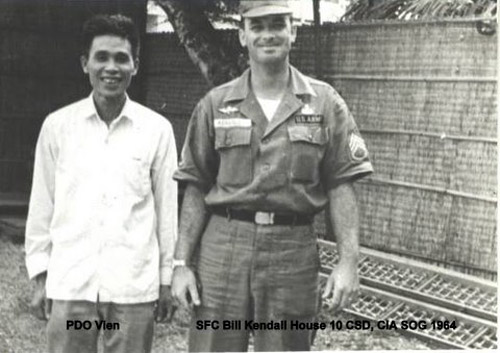
Bill Kendall and his PDO Vien at House 10, Saigon during 1964
Modern Forces: Can you recall a mission that stands out?
Bill Kendall: There a number of missions that were exciting to say the least. First one was in 1964-65 when the truck moving a team from House 10 to Camp Long Thank hit a road mine. It killed my driver and blew me out of the truck. Didn't really remember much for about 30 minutes. The PDO's set up a perimeter and shot anything that moved with 100 yards of the road. I ended up in the hospital after returning from the camp to my hotel a day later. Bad concussion. Was in the hospital for 4 days. COL Russell wanted to send me back to the states but I refused. SGT Pate talked into keeping me on the mission.
Ralph Rodd and myself with team Coloradl were in doing a BTA/BDA on an ARC lighted area of tunnels in 68 in either Juliet 8 or Hotel 9, don't remember. One of the indig team members jumped into the entrance of one of the tunnels and picked up a wire. Rodd and I both yelled at the same time but the booby trap went off. It blew a foot off of the indig and Rodd and I were pretty well filled with shrapnel from this. We took care of the indig using all of our morphine we had and I called for immediate extraction. We were pulled out about two hours later. I never knew what happened to the indig until Joe Parnar contacted me about 6-7 months ago. Joe was a medic at the camp at the time. I do remember the indig coming back to the camp some time later with artificial feet. Joe could tell you more about that than me.
On another mission with Bill Hanson we had a lot of fun with team Hawaii. We had no more been inserted and a tracking team with a dog was on us. They had us surrounded for three days until we could no longer move. On the third day we just knew we were done. We manage to set up a small perimeter to do the best we could. We had no idea how large the element was but it out numbered us without question For almost 3 hours we were able to hold them off. We have no idea how many we shot or killed outside our perimeter. At one time two of them got inside of us. I did kill both of them. Bill and I took turns calling for extraction. When the Huey's finally got there they were shot several times from ground fire. Air strikes were called in around us. We finally got half of the team out with the first chopper. It took more air strikes before the second one could get to get the rest of the team and Bill and I out. It took almost an hour and half to get back to Dak To, our launch site. Bill and I could not even walk for quite awhile because of our legs. No circulation in them. It was cut off because of the swiss seats we had to make out of our ropes.
Ethal Duffield and I had some exciting times to just playing hide and seek with some strange people. I guess you could say we all had that kind of fun. Joe Walker lived for this. Bob Howard did too. Allen Ferrall, Roy Lamphier, Van Han, Steve Keefer, Ben Thompson and the names go on and on. Fred Zabitosky was just like Bob Howard.
Modern Forces: Were your indigenous team members Montagyard, Nung or Vietnamese?
Bill Kendall: None of indig I ever worked with made it to the states as far as I know. The Chinese Nungs I never really knew even though I worked with some. The Yards all stayed at the other camp. Bob Howard worked with them most of the time with the Hatch Platoons and teams that went in.
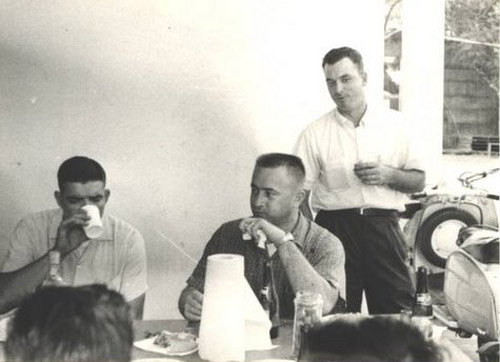
This picture is of Bill Kendall, Ray Riekel and one of the Case Officers (CSD<CIA) eating and getting ready for one of teams in 1964 at House 10
Modern Forces: Did you have a weapon choice or preference?
Bill Kendall: Weapons. Mostly the Car 15, sometimes the Swedish K and almost always cared a Browning 9mm. I never carried the SKS or AK47. Some of the guys did but I can't say who the were. I only carried as much ammo as I could, magazines only for the Car 15 and 9mm. When I had to use extra magazines I kept them most of the time. Lost some of a couple of times but that didn't appear to important at the time. I wonder why?? You would have to contact some of the other guys to see what they done. I don't really remember many of them bringing to many sticks (mags) back if the made contact.
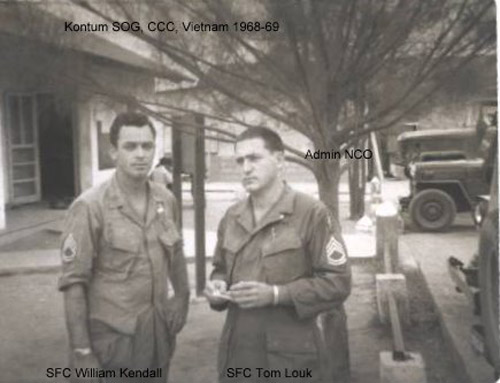
Bill Kendall and Tom Louk at CCC during 1968-69
Modern Forces: Did you have a standard equipment set-up in your team?
Bill Kendall: As far as equipment, rations, etc., most of the time it was basic loads depending on the number of days going in for. Basic load of ammo, claymores, CS, some grenades, rations, water but we carried a lot of iodine tablets with us. That didn't do me much good. Still developed a bad case of dysentery. That carried over with me in civilian life. Done a lot of damage to my stomach. Lost most of my colon and about 10 percent of my stomach two years ago because of it.

Bill Kendall (left) and Steve Keever (right) and RT Colorado running out of CCCs.
Modern Forces: It's well known that SOG used black spray paint to camouflage uniforms and equipment I have seen a picture of RT New York in Frank Greco’s second book that appears to show gear camo’d with green and black spray paint. Did you ever see this type of green/black spray paint in use?
Bill Kendall: To reply to the rest of your questions I have to say about the only clothes I wore during 1964-65 was civilian clothes. It was all I was authorized to wear working with the indig teams at the time and the PDO's. (Parachute Delivery Officers). These were highly trained Vietnams who would fly with the indig teams when they were being inserted by parachute during that period of time. They also only worn civies. I still have all of their names in my photo album with their pictures. I will never forget them..
As far as uniforms during 1968-69 mostly black or sterile jungle uniforms. I don't remember any other type during that time being worn. I will attach a picture of Steve Keefer's team showing the uniforms most teams wore. I should mention that Joe Walker always wore a head bandana and so did Ben Thompson. Most of us wore the basic rain cap with the brim.
I guess things really changed after 1969 from what I seen in some of the pictures on the site you indicated, modernforces. I know these uniforms became the norm after my time in Name. There are so many versions of the colors today with the working military uniforms I don't even recognize them.
Modern Forces: What did you do when you left the army, was this a career for you?
Nill Kendall: I retired in Sep 1974 and worked in a grocery store until fully retired in 1996. I did work at repairing sewing machines for about 5 years from 1991 until I had a heart problem in 1996. Nothing serious with the heart. My wife told them it was just to "cold". I am still kinda hard core about things.
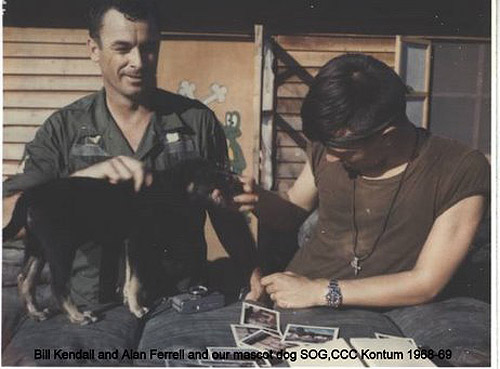
Bill Kendall and Alan Ferrall with the camp mascot, CCC Kontum.
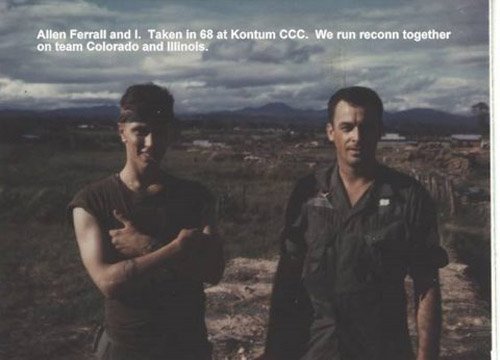
Bill Kendall and Alan Ferrall, CCC Kontum.
|

